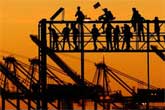As West coast dock workers and the ports, ocean carriers and terminals who employ them approach a month of working without a contract, automation of container handling remains probably the key issue.
Supply Chain Digest Says... |
 |
|
The ILWU is said to be pushing hard against further automation in the new contract, but details are few. |
|
 |
|
What do you say? |
|
| Click here to send us your comments |
|
| |
|
| Click here to see reader feedback |
|
|
|
That issue involves several dimensions, not only the possible loss of union jobs but also the on-going spectacle of ships off the ports of Los Angeles and Long Beach for days awaiting a berth, and the competitiveness of West coast ports in terms of cost and service versus alternatives.
Negotiations between the International Longshore and Warehouse Union (ILWU), which represents more than 22,000 longshoremen in 29 ports and terminals along the West Coast; and the Pacific Maritime Association (PMA), which represents interests of the same ports and terminals plus container lines, continue on. The previous contract ended June 30.
As reported by CNBC.com, the PMA wants to expand the use of remotely controlled cranes, which was agreed to by the union in a contract all the way back in 2008 – but little implemented to date, with just three terminals at LA/Long Beach having automated in part.
Also of interest: autonomous yard tractors that transport containers around the terminals.
In May, the PMA released a study that found that increasing use automation would enable the largest West Coast ports to remain competitive, would lead to growth in both cargo and jobs, and reduce greenhouse gas emissions as needed to meet stringent local environmental rules.
Of course, the ILWU released its own study in June which rebuts many of the points in the PMA study, notably the idea that port automation will increase jobs (through driving more container volumes.)
The US is behind in port automation. There are 939 container ports across the globe, according to data in 2020 from United Nations. Of those, according to a report by the International Transport Forum, only a little over 50 were automated. Most of those were automated in the past decade, and the majority are located in Asia and Europe. Several of the busiest global ports have some level of handling automation, includin in Shanghai, Singapore, Antwerp and Hamburg.
Of course there are varying degrees of port automation. According to CNBC, full automated mostly involves cranes and yard tractors that don’t require human operators onboard, and instead are remotely operated by humans in control towers.
(See More Below)
|
CATEGORY SPONSOR: SOFTEON |
|
|
|
|
|
 A semi-automated terminal generally has remote-controlled cranes but human-driven yard tractors. A semi-automated terminal generally has remote-controlled cranes but human-driven yard tractors.
There are barriers to West coast port automation. For example, The current contract has a pay-guarantee plan that ensures up to 40 hours of weekly income if an eligible ILWU member is unable to obtain full-time work for any reason, including automation.
So if that provision stays in place in a new contract, automation ROI is tough to find.
The ILWU is said to be pushing hard against further automation in the new contract, but details are few.
What’s more, the PMA report said its research showed the same number of workers are employed at automated and non-automated facilities.
Which side will blink on the issue of automation in the new contract? That is a huge question for the ILWU, the PMA – and global shippers.
What are your thoughts port automation? Let us know your thoughts at the Feedback section below.
Your Comments/Feedback
|

